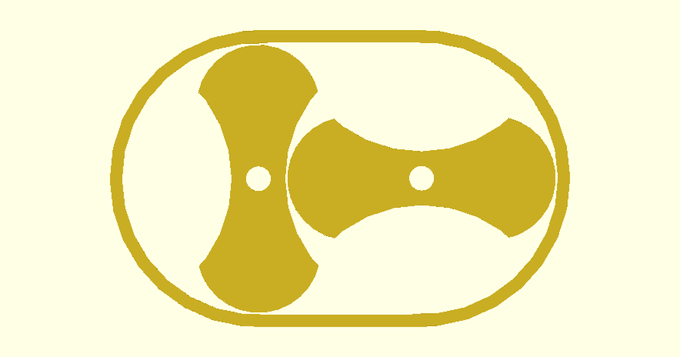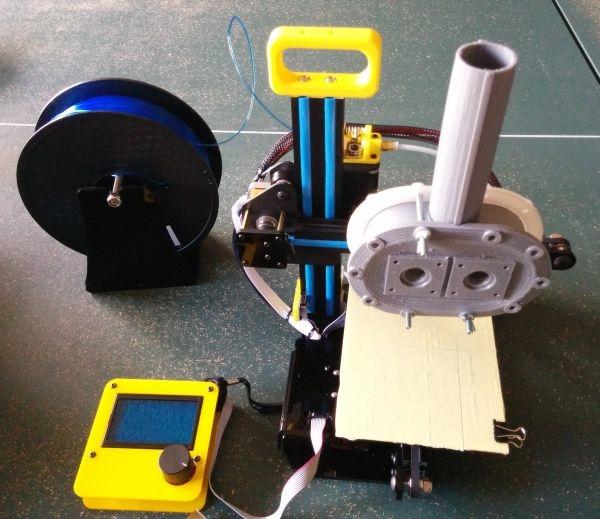Food will always have a strong, enticing niche in the 3D printing market. Those of us who love to cook and bake do so because we dream of the reward at the end of the process–and we enjoy pleasing others with delectable epicurean delights. Whether you are having pastries in the morning, a snack being shared at the office, or dessert around the jovial family dinner table on a relaxed Saturday night, sharing of food–and sweets–is a social and cultural experience we all enjoy.
We also enjoy our gadgets when it comes to cooking. And while everyone has the stray cake-pop, miracle pasta strainer, or egg cooker gimmicky device collecting dust in a cabinet somewhere, most cooks like to have quality cooking gadgets that will last–like that mixer your mother handed down to you. Those traditional tools may soon go by the wayside, however, as the technologically savvy foodies discover they can simply 3D print their own devices which can then be attached to the 3D printer for dough making.
The Dough Cannon is a device that is made for the baker’s baker. Made to be mounted on your own 3D printer, a concisely and cleverly engineered small pump is powered by two computer-controlled motors. The team behind it, TI3D, is based in Mt. Waverly, Australia. They have just launched a Kickstarter campaign to see an $85,000 AUD (about $62,720 USD) funding goal through by September 17th. And while the group at TI3D may know a thing or two about dough, they are also highly skilled in the areas of–no surprise–engineering and design, and industrial research. They enjoy translating their talents into the 3D arena, as one can see with their new 3D printed pump for food and dough.
The theme of sharing feeds through their business model as not only are they interested in sharing innovation and progress and helping you to break bread more efficiently with others, but through feedback from their users, they hope to create a whole community of food printers. They ask for both recipes and geometric forms from their users that they think would work with their innovative device as they continue to evolve further, publishing these contributions as an online resource.
“I got the idea for the Dough Cannon when we were making éclairs with choux pastry,” says Robert from TI3D. “The dough is quite thick and our piping bag was quite small. I thought it would be cool to design an electric pump so we could continuously feed dough – kind of like those cans of whipped cream.”
The team created the first prototype of the 3D printed device soon after, powering it with two stepper motors. While the concept is good, the motors slip while the dough is pumping, so they’ve outfitted the device with geared motors that are exponentially more powerful.
Realizing the Dough Cannon would work as a mounting apparatus, Robert found a 3D printer that could be modified so that they could easily attach the Dough Cannon. Several iterations were necessary, but they were able to complete a circuit board with a controller that functioned well for the system.
The current system works to make the 3D printer extrude (hopefully, whatever kind of dough you choose) dough through a piping bag coupler, allowing for the use of standard decorating nozzles. Not limited to any one food type, users can look forward to a wide range of applications for the device–from piping icing, to adding sauces to pizzas or as ornamentation. User will soon be pumping out fresh dough for gourmet doughnuts, chocolate éclairs, salty pretzels, and more.
 Not an egotistical lot, they are truly interested in finding out whether there is a real market for this thing, and they see the Kickstarter campaign as a great way to test the market.
Not an egotistical lot, they are truly interested in finding out whether there is a real market for this thing, and they see the Kickstarter campaign as a great way to test the market.
“So far we have built two working prototypes and have just sourced stronger motors so we can pump really thick dough,” states the TI3D team on Kickstarter. “We are really close to having the Dough Cannon operate just the way we want it to, but now we should talk to you, the group of people out there who might also want to print food.”
Funds from the campaign will also be used to finalize the design and make sure it is capable of handling all the needs users wish to use it for, as well as producing it in a food-safe material. You can support this project by pledging as little as $45 (all levels listed in AUD), and contributing recipes and/or forms to their online recipe book and resource system.
Early birds who pledge $300 receive the Dough Cannon kit, which includes a set of injection molded components, motors, controller and hardware. This is only available to 100 supporters. Those pledging $750 will receive the entire Dough Cannon kit and components, plus the 3D printer positioning system kit. The entire system arrives turnkey, with 3D printer at $1000–and if you throw in an extra $200, you can go to the TI3D offices for a training session.
Are you interested in combining 3D printing and dough making? Have you used an extruder for making food? If so, what types? Will you be supporting this campaign, or are you thinking about designing something similar? Discuss in the 3D Printed Dough Cannon forum thread over at 3DPB.com.
Subscribe to Our Email Newsletter
Stay up-to-date on all the latest news from the 3D printing industry and receive information and offers from third party vendors.
You May Also Like
Profiling a Construction 3D Printing Pioneer: US Army Corps of Engineers’ Megan Kreiger
The world of construction 3D printing is still so new that the true experts can probably be counted on two hands. Among them is Megan Kreiger, Portfolio Manager of Additive...
US Army Corps of Engineers Taps Lincoln Electric & Eaton for Largest 3D Printed US Civil Works Part
The Soo Locks sit on the US-Canadian border, enabling maritime travel between Lake Superior and Lake Huron, from which ships can reach the rest of the Great Lakes. Crafts carrying...
Construction 3D Printing CEO Reflects on Being Female in Construction
Natalie Wadley, CEO of ChangeMaker3D, could hear the words of her daughter sitting next to her resounding in her head. “Mum, MUM, you’ve won!” Wadley had just won the prestigious...
1Print to Commercialize 3D Printed Coastal Resilience Solutions
1Print, a company that specializes in deploying additive construction (AC) for infrastructure projects, has entered an agreement with the University of Miami (UM) to accelerate commercialization of the SEAHIVE shoreline...































